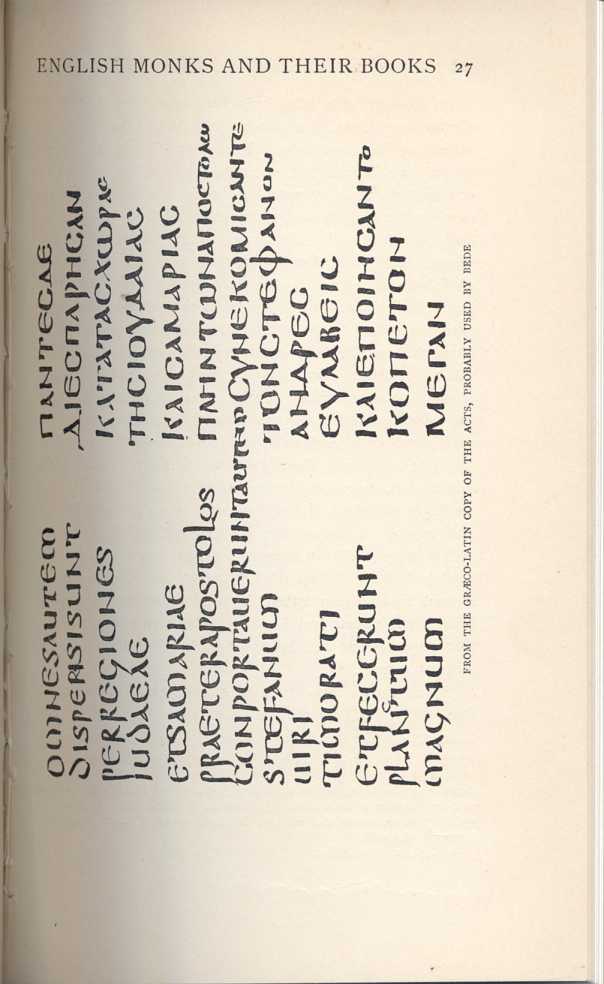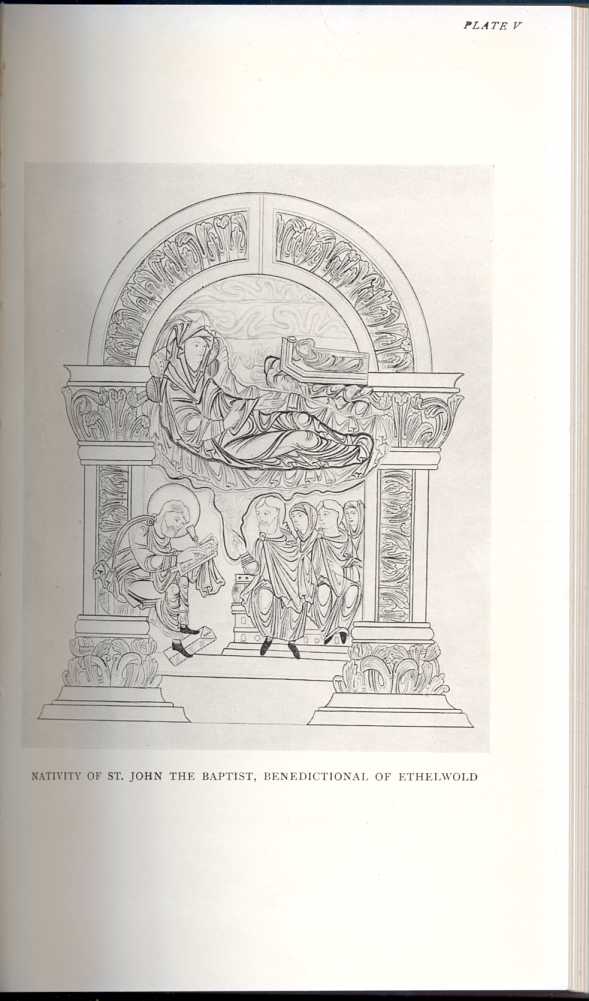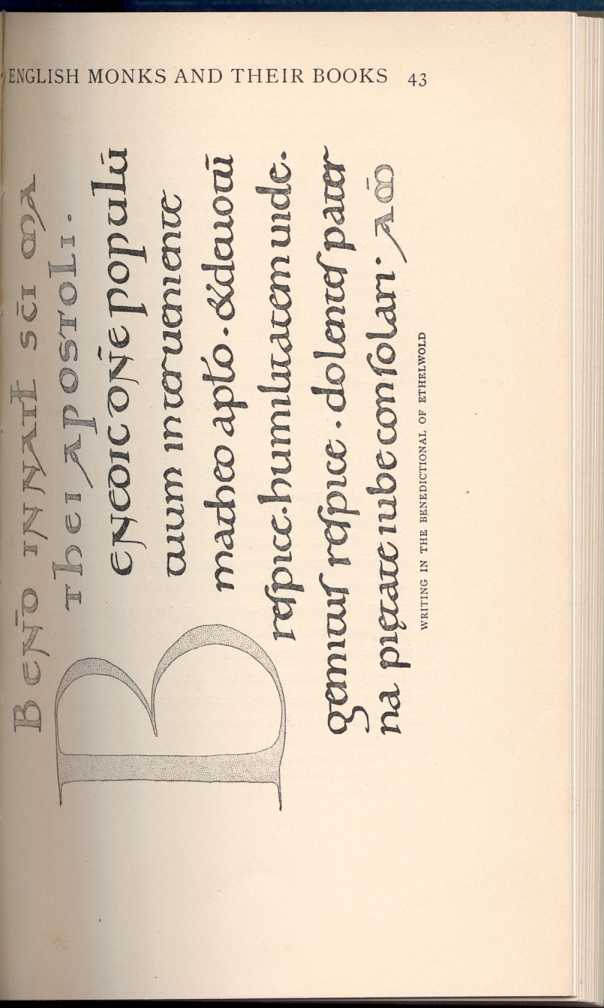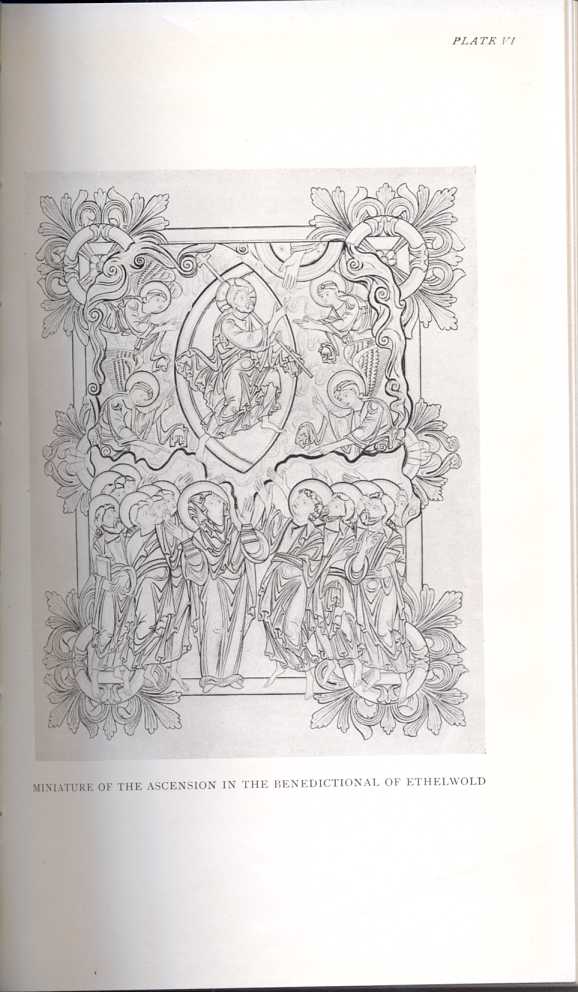| CHAPTER II: THE ENGLISH MONKS AND THEIR BOOKS Old English libraries; the making, collection and use of books during the middle ages | ||
2. CHAPTER II: THE ENGLISH MONKS AND THEIR BOOKS
1. § I
Richard De Bury, Philobiblon, Thomas' ed. 200
THE Benedictine order established monastic study on a regular plan. Benedict's forty-eighth rule is clear in its directions. "Idleness is hurtful to the soul. At certain times, therefore, the brethren must work with their hands, and at others give themselves up to holy reading." From Easter to the first of October the monks were required to work at manual labour from prime until the fourth hour. From the fourth hour until nearly the sixth hour they were to read. After their meal at the sixth hour they were to lie on their beds, and those who cared to do so might read, but not aloud. After nones work must be resumed until evening. From October the first until the beginning of Lent they were to read until the ninth hour. At the ninth hour they were to take their meal and then read spiritual works or the Psalms. Throughout Lent they were required to read until the
Benedict's inclusion of these directions was of capital importance in the advance of monkish learning. Being milder and more flexible, communal instead of eremitical, and so altogether more humane and attractive, his Rule gradually took the place of existing orders. And as the change came about, ill-regulated theological study gave way to superior methods of learning, solely due to the better organisation and greater liberality of the Benedictine order.
Benedictinism came to England with Augustine (597). The Rule, however, does not seem to have been strictly or consistently observed for a long time. But the studious labours of the monks remained just as important a part of their lives as they would have been had the monasteries closely followed Benedict's directions. Especially would this be the case in the seventh century, and afterwards, during the time continental monachism was in rivalry with the Celtic missionaries.
2. § II
From the first we hear of books in connexion with Canterbury. Gregory the Great gave to Augustine, either just before his English mission, or sent to him soon afterward, nine volumes, which were put in St. Augustine's monastery
No further hint of books occurs until Theodore became Archbishop more than seventy years later. Theodore, who had been educated both at Tarsus and Athens, where he became a good Greek and Latin scholar, well versed in secular and divine literature, began a school at Canterbury for the study of Greek, and provided it with some Greek books. None of these books has been traced with certainty. Some may have existed in Archbishop Parker's time. "The Rev. Father Matthew," says Lambarde, in his Perambulation of Kent, . . . "showed me, not long since, the Psalter of David, and sundry homilies in Greek, Homer also, and some other Greek authors, beautifully written on thick paper with the name of this Theodore prefixed in the front, to whose library he reasonably thought (being led thereto by show of great antiquity) that they sometime belonged." The manuscript of Homer, now in Corpus Christi Library, Cambridge, did not belong to Theodore, but to Prior Selling, of whom we shall hear later. But possibly the famous Graeco-Latin copy of the Acts, now in the Bodleian Library, belonged either to Theodore or to his companion, Hadrian.[2.6]
 [Description: FROM THE GRÆCO-LATIN COPY OF THE
ACTS, PROBABLY USED BY BEDE]
[Description: FROM THE GRÆCO-LATIN COPY OF THE
ACTS, PROBABLY USED BY BEDE]Theodore, with Hadrian's help, not only started the Canterbury School, but encouraged similar foundations in other English monasteries. In southern England, however, Canterbury remained the centre of learning, and many ecclesiastics were attracted to it in consequence. Bede amply proves its efficiency as a school. And forasmuch as both Theodore and Hadrian were "fully instructed both in sacred and in secular letters, they gathered a crowd of disciples, and rivers of wholesome knowledge daily flowed from them to water the hearts of their hearers; and, together with the books of Holy Scripture, they also taught them the metrical art, astronomy, and ecclesiastical arithmetic. A testimony whereof is, that there are still living at this day some of their scholars, who are as well versed in the Greek and Latin tongues as in their own, in which they were born."[2.7] Elsewhere he mentions some of these scholars by name. Albinus, already referred to as the first English abbot of St. Augustine's, "was so well instructed in literary studies, that he had no small knowledge of the Greek tongue, and knew the Latin as well as the English, which was his native language."[2.8] "A most learned man" was another disciple, Tobias, bishop of Rochester, who, besides having a great knowledge of letters, both ecclesiastical and general, learned the Greek and Latin tongues "to such perfection, that they were as well known and familiar to him as his native language." [2.9]
Canterbury's most notable scholar was Aldhelm, the first bishop of Sherborne. In him were united the learning of the Canterbury and the Irish monks, for he studied first under Maildulf, the Irish monk and scholar
Aldhelm at length became abbot of Malmesbury (c. 675), and under him it grew to much greater eminence, and attracted a large number of students. Here, in the solitude of the forest tract, he passed his time in singing merry ballads to win the ear of the people for his more serious words, playing the harp, in teaching, and in reading the considerable library he had at hand. Bede describes him as a man "of marvellous learning both in liberal and ecclesiastical studies." Judging by his writings he was in these respects in the forefront of his contemporaries, although his learning was heavy and pretentious. From them also it is perfectly evident he could make use not only of the Bible, but of lives of the saints, of Isidore, of the Recognitions of Clement, of the Acts of Sylvester, of writings by Sulpicius Severus, Athanasius, Gregory, Eusebius, and Jerome, as well as of Terence, Virgil, Horace, Juvenal, Persius, and Prosper, and some other authors.[2.11]
3. § III
Meanwhile Northumbria had become one of the leading centres of learning in Europe, almost entirely through the labours and influence of Irish missionaries. St. Aidan, an ascetic of Iona who journeyed to Northumbria at King Oswald's request, founded Lindisfarne, which became the monastic and episcopal capital of that kingdom. Aidan required all his pupils, whether religious or laymen, to read the Scriptures, or to learn the Psalms. The education of boys was a part of his system. Wherever a monastery was founded it became a school wherein taught the monks who had followed him from Scotland. Cedd, the founder and abbot of Lastingham, was Aidan's pupil, so was his brother, the great bishop Ceadda (Chad), who succeeded him in his abbacy. At Lindisfarne was wrought by Eadfrith (d. 721) the beautiful manuscript of the Gospels now preserved in the British Museum, and a little later the fine cover for it. Lastingham, founded on the desolate moorland of North Yorkshire, "among steep and distant mountains, which looked more like lurking-places for robbers and dens of wild beasts, than dwellings of men," upheld the traditions of the Columban houses for piety, asceticism, and studious occupations. Thither repaired one Owini, not to live idle, but to labour, and as he was less capable of studying, he applied himself earnestly to manual work, the while better-instructed monks were indoors reading.
In many directions do we observe traces of Aidan's good work. Hild, the foundress of Whitby Abbey, was for a short time his pupil. Her monastery was famous for having educated five bishops, among them John of Beverley, and for giving birth, in Caedmon, to the father of English poetry. "Religious poetry, sung to the harp as it passed from hand
Such progress would have been impossible had not the rulers of Northumbria from Oswald to Aldfrith been friendly to Christianity. Aldfrith had been educated at Iona, and was a man of studious disposition. His predecessor had advanced Northumbria's reputation enormously by giving Benedict Biscop (629-90) sites for his monasteries of Wearmouth and Jarrow.[2.13] We know enough of this Benedict to wish we knew very much more. He suggests to us enthusiasm for his cause, and energy and foresight in labouring for it. Naturally, Aldhelm's writings have gained him far more attention in literary histories than the Northumbrian has received. But the influence of Benedict, a man of much learning, wide-travelled, was at least as great and as far-reaching Lérins, the great centre of monachism in Gaul, and Canterbury under Theodore, had been his schools. On six occasions he flitted back and forth to Rome, and to go
4. § IV
Canterbury, Malmesbury, Lindisfarne, Wearmouth and Jarrow, and York were like mountain-peaks tipped with gold by the first rays of the rising sun, while all below remains dark. Yet while not indicative of widespread means of instruction, the existence of these centres, and the character of the work done in them, suggests that at other places the same sort of work, on a smaller and less influential scale, soon began. At Lichfield, on the moorland at Ripon, in "the dwelling-place in the meadows" at Peterborough, in the desolate fenland at Crowland and at Ely, on the banks of the Thames at Abingdon, and of the Avon at Evesham, in the nunneries of Barking and Wimborne, at Chertsey,
A decree of the Council held at Cloveshoe in 747, pointing out the want of instruction among the religious, and ordering all bishops, abbots, and abbesses to promote and encourage learning, whether it means that monkish education was on the wane or that it was not making such
Alcuin was brought up at York from childhood. In company with Albert, who taught the arts and grammar at this northern school, Alcuin visited Gaul and Rome to scrape together a few more books. On returning later he was entrusted with the care of the library: a task for which he was well fitted, if enthusiasm, breaking into rime, be a qualification:—
Which you, reader, rejoice piously here to receive;
Better than richest gifts of the Kings, this treasure of Wisdom,
Light, for the seeker of this, shines on the road to the Day."[2.20]
Alcuin was soon at the head of St. Martin's of Tours
remain; There all the Latin writers make their home With those that
glorious Greece transferred to Rome,— The Hebrews draw from their
celestial stream, And Africa is bright with learning's beam."
Then, after including in his metrical catalogue the names of forty writers, he proceeds:—
Famed for their style, the masters of old lore,
Whose many volumes singly to rehearse
Were far too tedious for our present verse."[2.21]
5. § V
Sunlight and shadow follow one another rapidly across England's early history. The migration of York's renowned scholar took place six years before the Viking irruptions began, and about twelve years before a heavy blow was struck at Northumbrian learning by the ravaging and destruction of the monasteries of Lindisfarne, and Wearmouth and Jarrow. After this there was but little peace for England. Kent was often attacked. In 838 the marauders fell upon East Anglia. Between 837 and 845 they made various fierce attacks upon Wessex. In 851 the pillage of Canterbury and London was a severe blow to the English. About fifteen years later, at the hands of the Danes, Melrose, Tynemouth, Whitby, and Lastingham shared Wearmouth's fate. Of York and its library we hear no more. Peterborough and its large collection of sacred books perished at the hands of the same raiders as those who burnt Crowland (870). So bad grew affairs that Alfred the Great, writing to Bishop Werfrith, bewailed the small number of people south of the Humber who understood the English of their service, or could translate from Latin into English. Even beyond the Humber there were not many; not one could he remember south of the Thames when he began to reign. And he bethought himself of the wise men, both church and lay folk, formerly living in England, and how zealous they were in teaching and learning, and how men came from abroad in search of wisdom and instruction. Apparently some decline from this standard had been noticeable before ruin completely overtook the monasteries. He remembered how, before the land had been ravaged and burnt, "its churches stood filled with treasures and books,
This letter, written in 890, marks the revival of interest in letters under Alfred. In adding to his own knowledge, and in promoting education among his people, he was assiduous and determined. During the leisure of one period of eight months, Asser seems to have read to him all the congenial books at hand, Alfred's custom being to read aloud or to listen to others reading. Asser was a Welsh bishop, brought to Wessex to help the king in his work. For the same purpose Archbishop Plegmund[2.23] and Bishop Werfrith were brought from Mercia. Other scholars came from abroad. One named Grimbald, a monk from St. Bertin, came to take charge of the abbey of Hyde, Winchester, which Alfred had planned. John, of Old-Saxony, a learned monk of the flourishing Westphalian Abbey of
That Alfred, amid the cares of a troublesome kingship, could find time to devote to this work, and realised the importance of vernacular literature, is one of the chief signs of his greatness. What he did had a lasting influence upon our literature. He tapped the wellspring of English prose. Mainly owing to his initiative, from his day till the Conquest all the literature of importance was in the vernacular, and the impulse so given to the language as a literary vehicle was strong enough to preserve it from extinction during the Norman domination, when it was superseded as the court and official language. But, so far as the making and circulation of books is concerned, the "revival" under Alfred did not prosper. The necessary machinery was almost entirely wanting. The monastic schools, the great—the only—means of disseminating the learning of the time, were few in number and not very influential. For Athelney, a small monastery, Alfred had difficulty in finding monks at all: he had to get them from abroad; while the rule in this house does not seem to have been wholly satisfactory. At the time of his death (c. 901) monachism was in a bad way. Fifty years later its plight would seem to have been worse. Only two houses, Abingdon and Glastonbury, could be really called monastic. "In the middle of the tenth century the Rule of St.
The leaders were Dunstan and Ethelwold. In youth the former was renowned for his eagerness in studying, and for the wealth and knowledge he acquired. He was a "lover of ballads and music," "a hard student, an indefatigable worker, busy at books"; spending his leisure in reading sacred authors, and in correcting manuscripts, sometimes at daybreak. He was also very skilful at working in metal
Some beautiful examples of work of this period have been
preserved. "Winchester" work is a familiar and expressive term in
illumination, and nobody will ask why this is so if they have seen a
manuscript executed there towards the end of the tenth century. The
Benedictional and Missal of Archbishop Robert, which is certainly
English, and most likely an example of New Minster work, is illuminated
with miniatures, foliated and architectural borders, and capitals and
letters of gold, in virile workmanship. A still finer example—the
finest example of Old Minster craft—is the Benedictional of Ethelwold,
now in the Duke of Devonshire's library. The versified dedication,
inscribed in letters of gold, tells us, in substance—"The Great
Æthelwold . . . illustrious, venerable and mild . . . commanded a
certain monk subject to him to write the present book: he ordered also
to be made in it many arches elegantly decorated and filled up with
various ornamented pictures expressed in divers beautiful colours, and
gold."[2.30] Godeman, abbot of Thorney, was
the scribe, but the illuminator is unknown. Each full page has nineteen
lines of writing, with letters nearly a quarter of an inch long.
Alternate lines in gold, red, and black occur once or twice in the same
page. There are thirty miniatures and thirteen fully illuminated pages,
some of these having framed borders, foliated, others columns and
arches. The figures are remarkably well drawn, the drapery being
especially good. The whole is in a fine state of preservation,
especially the gold ornaments; the gold used was leaf upon size,
afterwards well burnished. Of the rival craftsmanship at New Minster we
have a splendid example in the Golden Book of Edgar, so called
 [Description: NATIVITY OF ST. JOHN THE BAPTIST,
BENEDICTIONAL OF ETHLWOLD]
[Description: NATIVITY OF ST. JOHN THE BAPTIST,
BENEDICTIONAL OF ETHLWOLD]
 [Description: WRITTING IN THE BENEDICTIONAL OF
ETHLWOLD]
[Description: WRITTING IN THE BENEDICTIONAL OF
ETHLWOLD]One of Ethelwold's pupils was Ælfric, who became Archbishop of Canterbury in 995. He was responsible for the canon requiring every priest, before ordination, to have the Psalter, the Epistles, the Gospels, a Missal, the Book of Hymns, the Manual, the Calendar, the Passional, the Penitential, and the Lectionary. On his death he bequeathed all his books to St. Albans.[2.32]
Another pupil of the same name is still more famous. This scholar's grammar, with its translated passages, his glossary—the oldest Latin-English dictionary—and his conversation-manual of questions and answers, with interlinear translations, suggest that he must have done much to make the study of Latin easier and more congenial; while his homilies display his art in making knowledge popular, and prove him to be the greatest master of English prose before the Conquest.
Several other interesting and suggestive facts belonging to this period have been preserved for us. Abbot Ælfward, for example, gave to his abbey of Evesham many sacred books and books on grammar (c. 1035): here, at any rate, progress was real. [2.33] At a manor of the abbey of Bury St. Edmunds were thirty volumes, exclusive of church books (1044-65). [2.34] Bishop Leofric also obtained over sixty books for Exeter Cathedral about sixteen years before the Conquest, a collection to which we must refer later.
 [Description: MINIATURE OF THE ASCENSION IN THE
BENEDICTIONAL OF ETHELWOLD]
[Description: MINIATURE OF THE ASCENSION IN THE
BENEDICTIONAL OF ETHELWOLD]
Hist. mon. S. Augustini, Cant., 96-99, "Et haec sunt primitiae librorum totius ecclesiae Anglicanae," 99.
B. M. Reg. I. E vi. may be a part of the Gregorian Bible, or the second copy of the Gospels mentioned above, if this second copy is not Corpus Christi, Camb. 286. Corpus C. 286 is a seventh century book, certainly from St. Augustine's; it was probably brought to England in the time of Theodore, and though it may be one of the books referred to above, is, therefore, not Augustinian. The Psalter bearing the silver images is "most likely" Cott. Vesp. A. I, an eighth century manuscript; it is, therefore, not Augustinian, although it may be a copy of the original Psalter given by Gregory.—James, lxvi.
Known as Codex E, or the Laudian Acts (Laud. Gr. 35). Bede refers to a Greek manuscript of the Acts in his Retractationes; possibly this is the actual copy. The last page of the book bears the signature "Theodore"; did Archbishop Theodore bring the volume to England?" It is at least safe to say that the presence of such a book in England in Bede's time can hardly be entirely independent of the influence of Theodore or of Abbot Hadrian."— James (M. R.), xxiii.
This copy was still at Malmesbury in the twelfth century.—W. of Malmesbury, Ang. Sacr., ii. 21.
These foundations were regarded as one house, the inmates being bound together by "a common and perpetual affection and intimacy."
Ceoffrid, Benedict Biscop's successor, added a number of books to the library, among them three copies of the Vulgate, and one of the older version. One copy of the Vulgate Ceolfrid took with him to Rome (716) to give to the Pope. He died on the way. The codex did not go to Rome; now, it is in the Laurentian Library, Florence, where it is known as the Codex Amiatinus. The writing is Italian, or at any rate foreign, so it must have been imported, or written at Jarrow by foreign scribes. This volume is the chief authority for the text of Jerome's translation of the Scriptures.
Bede frequently quotes Cicero, Virgil, and Horace; usually selecting some telling phrase, e.g. "caeco carpitur igni" (H. E. ii. 12). In his De Natura rerum he owes a good deal to Pliny and Isidore. In his commentaries on the Scriptures he displays an extent of reading which we have no space to give any idea of. His chronologies were based on Jerome's edition of Eusebius, on Augustine and Isidore. In his H. E. he uses "Pliny, Solinus, Orosius, Eutropius Marcellinus Comes, Gildas, probably the Historia Brittonum, a Passion of St. Alban, and the Life of Germanus of Auxerre by Constantius"; while he refers to lives of St. Fursa, St. Ethelburg, and to Adamnan's work on the Holy Places. Cf. Sandys, i. 468; Camb. Lit., i. 80-81. Bede also got first-hand knowledge: the Lindisfarne records provided him with material on Cuthbert; information came to him from Canterbury about Southern affairs and from Lastingham about Mercian affairs. Nothelm got material from the archives at Rome for him.
Tr. in King's Letters, ed. Steele (1903), I. Cf. Bodl. MS Hatton, 20; Cott. MS. Otho B 2; Corpus C. C., Camb. MS. 12.
MS. Cott. Tib. B xi.—a copy of Alfred's version of the Cura, or what is left of it—has been connected with Archbishop Plegmund, the evidence being a Saxon inscription on the manuscript Wanley, however, doubted the conclusiveness of this evidence, which, together with most of the text, was lost in the fire of 1731. —James, xxiii-iv.
| CHAPTER II: THE ENGLISH MONKS AND THEIR BOOKS Old English libraries; the making, collection and use of books during the middle ages | ||